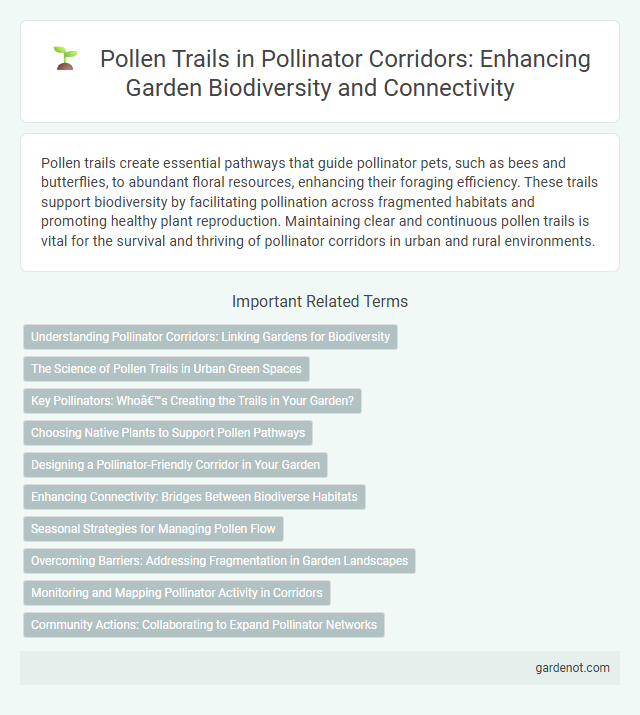Pollen trails create essential pathways that guide pollinator pets, such as bees and butterflies, to abundant floral resources, enhancing their foraging efficiency. These trails support biodiversity by facilitating pollination across fragmented habitats and promoting healthy plant reproduction. Maintaining clear and continuous pollen trails is vital for the survival and thriving of pollinator corridors in urban and rural environments.
Understanding Pollinator Corridors: Linking Gardens for Biodiversity
Pollinator corridors create continuous pollen trails by linking gardens, enhancing habitat connectivity that supports diverse pollinator species such as bees, butterflies, and hummingbirds. These corridors facilitate the movement and foraging of pollinators, boosting plant reproduction and genetic diversity across fragmented urban and rural landscapes. Integrating native flowering plants along these connected green spaces increases biodiversity and strengthens ecosystem resilience.
The Science of Pollen Trails in Urban Green Spaces
Pollen trails in urban green spaces play a crucial role in supporting pollinator movement and enhancing biodiversity by creating connected habitats. Studies show that strategically planting native flowering species along these corridors increases pollen availability, which directly improves the foraging efficiency of bees and other pollinators. Mapping pollen distribution through DNA metabarcoding and GIS technology helps urban planners optimize green corridors for sustained ecological health and pollinator population growth.
Key Pollinators: Who’s Creating the Trails in Your Garden?
Key pollinators creating pollen trails in your garden include native bees, butterflies, and hummingbirds, each contributing uniquely to plant reproduction and biodiversity. Native bees, such as bumblebees and mason bees, are highly effective at transferring pollen between flowers, ensuring robust crop yields and vibrant wildflower populations. Butterflies and hummingbirds not only enhance pollination but also support the ecological balance by enabling cross-pollination among diverse plant species within the pollinator corridor.
Choosing Native Plants to Support Pollen Pathways
Selecting native plants for pollen pathways enhances the effectiveness of pollinator corridors by providing local pollinators with familiar and nutrient-rich pollen sources. Native species such as milkweed, goldenrod, and coneflower offer essential habitats that support the lifecycle of bees, butterflies, and other pollinators, boosting biodiversity and ecosystem resilience. Maintaining a diverse array of native flowering plants ensures continuous pollen availability throughout the growing season, reinforcing the integrity of pollinator networks.
Designing a Pollinator-Friendly Corridor in Your Garden
Creating a pollinator-friendly corridor in your garden involves planting a diverse array of native flowering plants that bloom sequentially throughout the seasons to provide a continuous pollen trail for bees, butterflies, and other pollinators. Incorporate layers of vegetation, including ground covers, shrubs, and trees, to offer shelter and varied foraging options, enhancing habitat connectivity. Avoid pesticides and ensure access to clean water sources to support pollinator health and encourage regular visitation along the corridor.
Enhancing Connectivity: Bridges Between Biodiverse Habitats
Pollen trails serve as vital links enhancing connectivity between fragmented biodiverse habitats by facilitating the movement of pollinators such as bees, butterflies, and hummingbirds. These biological corridors improve genetic exchange among plant populations, boosting ecosystem resilience and productivity. Integrating diverse native flowering plants along these trails supports continuous foraging resources, ensuring pollinator survival and habitat cohesion.
Seasonal Strategies for Managing Pollen Flow
Seasonal strategies for managing pollen flow in pollinator corridors emphasize synchronizing plant bloom periods to ensure continuous pollen availability from early spring to late fall. Implementing diverse native plant species with staggered flowering schedules supports sustained foraging opportunities, enhancing pollinator health and ecosystem resilience. Monitoring pollen trail patterns guides adaptive management, improving corridor effectiveness in facilitating pollinator movement and genetic exchange.
Overcoming Barriers: Addressing Fragmentation in Garden Landscapes
Pollen trails create crucial connections between isolated garden patches, facilitating pollinator movement and genetic exchange despite urban fragmentation. Strategic planting of native flowering species along these corridors enhances habitat quality and continuity, reducing barriers that impede pollinator navigation. Implementing green infrastructure such as hedgerows and flowering ground cover effectively restores ecological networks in fragmented garden landscapes.
Monitoring and Mapping Pollinator Activity in Corridors
Monitoring and mapping pollinator activity in corridors involve tracking pollen trails using GPS-enabled devices and remote sensing technologies to collect precise data on pollinator movement patterns. Advanced GIS software processes this data, creating detailed maps that illustrate the intensity and frequency of pollination routes within designated corridors. Such spatial analysis helps identify critical habitats, optimize corridor design, and enhance conservation strategies for sustaining pollinator populations.
Community Actions: Collaborating to Expand Pollinator Networks
Community actions in establishing pollen trails strengthen pollinator corridors by linking isolated habitats through native flowering plants, enhancing pollinator movement and genetic diversity. Local groups collaborate with environmental organizations to identify key areas for planting, ensuring continuous floral resources across urban and rural landscapes. These coordinated efforts expand pollinator networks, boosting ecosystem resilience and supporting sustainable agricultural production.
Pollen trail Infographic

 gardenot.com
gardenot.com